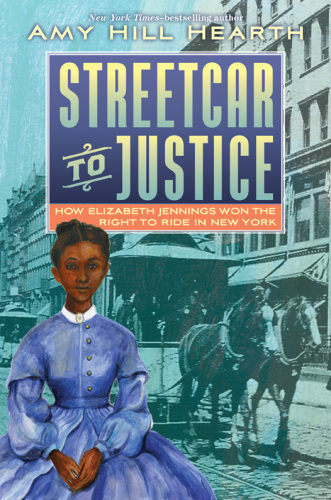
Streetcar to Justice
How Elizabeth Jennings Won the Right to Ride in New York
فرمت کتاب
ebook
تاریخ انتشار
2018
Lexile Score
1120
Reading Level
6-9
ATOS
7.7
Interest Level
4-8(MG)
نویسنده
Amy Hill Hearthناشر
Greenwillow Booksشابک
9780062675934
کتاب های مرتبط
- اطلاعات
- نقد و بررسی
- دیدگاه کاربران
نقد و بررسی

Starred review from October 16, 2017
Hearth (The Delany Sisters Reach High) draws on her journalism roots to carefully piece together the story of a mostly forgotten figure in the struggle for racial equality in the United States. African-American schoolteacher Elizabeth Jennings vehemently fought back when she was refused streetcar service in 1854 Manhattan; her victorious court case against the streetcar company helped integrate public transportation in New York. Hearth grounds Jennings’s story in vivid sensory detail: “she would have walked around piles of horse manure and maybe even the bloated remains of a dead animal or two.” Fifteen chapters pack in contextualizing information, often in sidebars, educating readers on topics ranging from Jim Crow laws and de facto segregation in the north to Jennings’s contemporaries Frederick Douglass and Chester Arthur (Jennings’s lawyer and future U.S. president). Archival photos, newspaper clippings, and resources that include a timeline of Jennings’s life (she founded the first kindergarten for black children in New York City) augment a book that belongs in any civil rights library collection. Ages 8–12. Agent: Mel Berger, William Morris Endeavor.

January 1, 2018
Gr 4-7-Hearth sets the stage in this middle grade biography with Elizabeth Jennings hoping to arrive on time at the First Colored American Congregational Church, where she was an organist, before pulling back to explain just what New York City looked, smelled, and operated like in 1854. Weaving together historical background with a portrait of Jennings, Hearth has created a compelling account of the court case Jennings vs. Third Avenue Railroad Company-an early landmark case in desegregating New York City transit. The engaging narrative is supported by plentiful archival maps, photos, and reproductions of primary source documents, such as handwritten reports and newspaper clippings. Sidebars also provide important historical context. The back matter is impressively long-including a six-page bibliography of websites, books, newspapers, journals and reports; extensive chapter and illustration notes; and more, making this a superb mentor text. VERDICT Hearth brings the story of Elizabeth Jennings to vivid life in an eminently readable book.-Brenda Kahn, Tenakill Middle School, Closter, NJ
Copyright 2018 School Library Journal, LLC Used with permission.

October 15, 2017
Grades 5-8 When Elizabeth Jennings, a young black woman on her way to church, refused to vacate a New York City streetcar and was literally torn off of it by its driver and roughed up by that driver and a police officer, there was no one around to photograph the event. Luckily, though, there were people who took up her cause for justice, including a young lawyer who went on to become a U.S. president (Chester Arthur). It was 1854, years before the Civil War and emancipation, and a century before Rosa Parks similarly stood her ground. But few people know about Jennings and how her case impacted discrimination laws in the northern city, where she lived as a free black gentlewoman. Hearth places this obscure gem of a story in context: illustrations from the era and extensive notes and references help readers follow the story. Those interested in the myriad origins of the civil rights movement will be fascinated by the case and how it galvanized the black community of its day.(Reprinted with permission of Booklist, copyright 2017, American Library Association.)

























دیدگاه کاربران